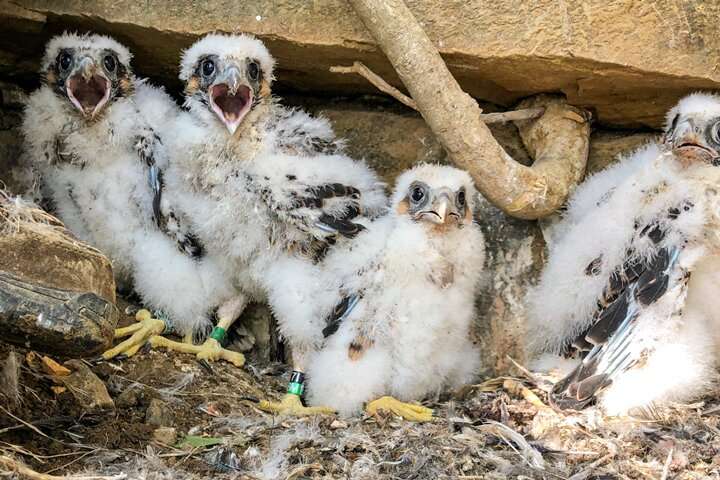High-adventure bird banding with the Center for Conservation Biology

Sometimes bird banding is a rather sedate activity. You set up your mist nets a few steps away from your truck, open up a chair and wait.
Other times, bird banding means hanging from a rope high above a quarry, one cheek on a rock ledge, working with one hand for the bird and one hand for yourself.
Bryan Watts found himself in just such a situation recently during a trip to the Luck Stone quarry in Ashburn, Virginia. Watts, the director of the Center for Conservation Biology, was partnering with Shenandoah National Park Ecologist Alan Williams to band a set of peregrine nestlings.
"This is a new nest site this year and the eyrie is up on a quarry high wall," Watts said. Approaching the nest required Watts and Williams to use rock-climbing techniques, all the while keeping an eye out for the parent birds.
Watts said that he hoped they could extract the birds from the nest and do the banding on a ledge that was about seven feet below the nest crevice. But the ledge turned out to be even narrower than it first appeared.
"I could only fit one cheek on the ledge while pulling the birds and boxing them up," he said. "I had to rely on stabilizing myself with the climbing line."
Williams had some climber's rock anchors, which the two used to hang their gear on the rock wall for the banding process, which also includes weighing and taking several measurement of each bird.
"If we do it again, we will likely rappel down, pull the birds and ascend back up to band them on top," Watts said.
And Watts hopes that he will be back to band again.
"Luck Stone said that it was a really good experience so hopefully we can band again next year," he said. "They are phasing out this part of the quarry so we are hopeful that it may be a long term breeding site."
Watts praised Luck Stone officials for their cooperation in the banding venture.
"We talked to them in April and they had a lot of safety concerns about letting us access the nest," Watts said.
"It turns out that their head of risk management, Abel Parker, is a William & Mary graduate and he ultimately signed off on it. It also helped that the regional manager is a birder and really likes the birds being there."
The CCB has been instrumental in the successful restoration efforts of the peregrine falcon in Virginia. The raptors were believed to be extirpated in the commonwealth by the early 1960s. Early reintroduction efforts, spearheaded by CCB Director Emeritus Mitchell Byrd, centered on the release of captive-reared birds into the wild.
The CCB scientists used a technique known as "hacking," a centuries-old method perfected by the sport falconers of a previous age. Hacking involves construction of artificial eyries for the young birds and a provisioning and monitoring regimen to acclimate the captive birds to their new life in the wild.
Peregrines like to build their eyries in the highest places they can find and Virginia's newly established population of peregrines has shown a preference for establishing eyries atop electric transmission towers, tall buildings, bridges and other artifacts of civilization, especially on the flattish Coastal Plain of Virginia.
The Luck Stone peregrines brought off a brood of three males and one female at a site that was not exactly natural, but closer to a mountain cliff than a skyscraper. Watts said the young birds were in good health and at a fine age for banding. He found evidence that the peregrine parents were good providers, as well.
"I collected bands from four homing pigeons from the nest ledge and there also were feathers from blue jays, grackles, cardinals and yellow-billed cuckoo," Watts said.
The Center for Conservation Biology is a joint program of William & Mary and Virginia Commonwealth University.
Provided by The College of William & Mary